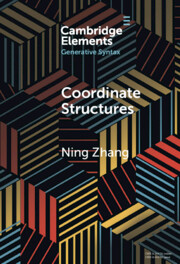Element contents
Coordinate Structures
Published online by Cambridge University Press: 21 November 2023
Summary
- Type
- Element
- Information
- Series: Elements in Generative SyntaxOnline ISBN: 9781009326643Publisher: Cambridge University PressPrint publication: 14 December 2023
References
- 1
- Cited by



